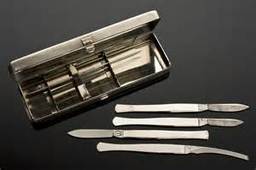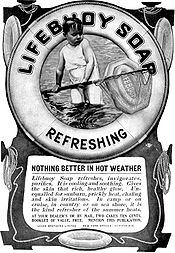
Dr. Joseph Lister, of Scotland, 1827-1912, was a Professor of Surgery at Glasgow University. He was aware that many people survived the trauma of surgery but then died of what was known as 'ward fever'. In 1865, he learned of the work of a Hungarian surgeon named Semmelweis, who insisted on the use of a solution of calcium chloride as an antiseptic before surgery, and whose patient survival rate was much improved as a result. Lister put this information together with what he had learned of Louis Pasteur's germ theory, which stated that infections were caused by airborne microbes that entered any wound in the skin.
Lister cut the death rate from 'ward fever' among his surgical patients from 45% to 15% in less than 4 years by insisting on absolute cleanliness in the operating theatre.
All surgeons, assistants and nurses, had to wear clean gowns and scrub their hands with carbolic soap before entering his operating theatre, all instruments were sterilized in a solution of carbolic acid and he also developed a machine that would spray a fine mist of carbolic acid over the instruments and bandages. Lister also 'washed' the area of surgery with this antiseptic solution before and after surgery to prevent sepsis. Because of his work, Joseph Lister is called the Father of Antiseptic Surgery,
The crucial discovery of what Pasteur's microbes really were - bacteria - occurred when specific bacteria were identified by Koch. By 1878, Koch knew which bacteria caused septicaemia (blood poisoning), by 1882, he knew which caused Tuberculosis, and by 1883, Cholera. The puzzle pieces were being put together, but following Lister's work ,surgeons knew that all bacteria must be prevented from entering surgical wounds. By 1890, all surgical instruments were boiled to sterilize them and by 1901, surgeons began wearing rubber gloves and face masks.
Robert was a disciple of Lister and in the in the early years of the twentieth century, he employed all these measures which meant his patients seldom died of post operative infections. Along with his surgical instruments, he carried a solution of carbolic acid in his medical bag, and he insisted carbolic acid be used to wash down patients when injuries occurred in the mines or on the farms.
I'm sure some of those readers who have long memories will recall LIFEBOUY soap, but i wonder if you knew that it was an offshoot of Lister's work and that it was a carbolic or coal tar soap, with strong antimicrobial properties thus acting as a mild antiseptic.
To learn more about this topic go to:
http://www.historylearningsite.co.uk/a-history-of-medicine/joseph-lister/
http://www.biography.com/people/joseph lister-37032

 RSS Feed
RSS Feed
